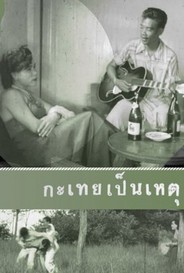|
Afrodita
|
Pierre Marchal
(aka Luis Moglia Barth)
|
1928
|
Argentina / 50 mins
This unusual film is based on the novel of the same name by Pierre Louys and takes place in Greek Egypt (circa 57 BC), where "there is nothing under the sun more sacred than physical love and nothing more beautiful than the human body". It narrates a formidable love affair between the sculptor Demetrio and the courtesan Khrysé: to give herself to him, she demands three precious objects that involve three crimes: a robbery, a murder, a sacrilege. The film premiered in Buenos Aires as if it were a French production, with the warning that it contained "artistic nudity" and that it was not suitable "for minors and young ladies." Despite all this, he was banned after a campaign launched by the Catholic newspaper El Pueblo and was never heard from again. Only in an interview in 1973 did the director Luis Moglia Barth acknowledge his authorship, perhaps assuming that the film no longer existed. However, there was a copy in the collection of the critic Manuel Peña Rodríguez, preserved in the Museo del Cine, although under another name and with scattered fragments in different cans. At the end of 2008 it was identified and rebuilt, as far as possible, by Fernando Martín Peña. The strange history of the film leaves the director's technical and artistic collaborators a mystery, but it is known that it was produced by the same company as El 90 (Argentine Cinematographic Union) and therefore it is to be assumed that, as in this film, the photography has been in charge of Gumer Barreiros and the scenery of Juan Manuel Concado.
Este film insólito se basa en la novela homónima de Pierre Louys y transcurre en el Egipto griego (hacia el año 57 a.C.), donde “no hay bajo el sol nada más sagrado que el amor físico y nada más bello que el cuerpo humano”. Narra un formidable desencuentro amoroso entre el escultor Demetrio y la cortesana Khrysé: para entregársele, ésta le exige tres objetos preciosos que implican tres crímenes: un robo, un asesinato, un sacrilegio. El film se estrenó en Buenos Aires como si se tratara de una producción francesa, con la advertencia de que contenía “desnudos artísticos” y que no era apto “para menores y señoritas”. Pese a todo ello quedó prohibido tras una campaña emprendida por el diario católico El Pueblo y nunca volvió a saberse de él. Recién en una entrevista de 1973 el director Luis Moglia Barth reconoció su autoría, suponiendo quizá que el film ya no existía. Sin embargo, había una copia en la colección del crítico Manuel Peña Rodríguez, preservada en el Museo del Cine, aunque bajo otro nombre y con fragmentos dispersos en latas distintas. A fines de 2008 fue identificada y reconstruida, hasta donde fue posible, por Fernando Martín Peña. La extraña historia del film deja en el misterio a los colaboradores técnicos y artísticos del director, pero se sabe que fue producido por la misma empresa que El 90 (Unión Cinematográfica Argentina) y por lo tanto es de suponer que, como en este film, la fotografía haya estado a cargo de Gumer Barreiros y la escenografía de Juan Manuel Concado.
|
|

It’s All Because of a Katoey
|
Ledger Group
|
1954
|
Thailand / 12 mins
This 12-minute silent comedy with intertitles was made by a group of amateur filmmakers at Monthon Bank (later incorporated by Krung Thai Bank) in 1954. “Katoey” in the title is a broad term refering to a ladyboy or effeminated gay man. The slapstick narrative concerns a group of male friends who’re hanging out when a beautiful woman appears. Seduced by their beauty, the men only learn much later that she’s not a woman but actually a katoey. “Katoey Pen Het”, or “It’s All Because of a Katoey”, is the oldest Thai film with an LGBT character ever discovered by the Thai Film Archive. The portrayal of katoey as a comic character has long been a staple of Thai media, but this film, by making the katoey a fiancee of one of the men, displays a progresstive attidue that even Thai films in the modern period rarely show.
Watch... here
|
|
Nomades Afghans
|
Ella Maillart
|
1939
|
Switzerland / 37 mins
In 1939, Ella Maillart undertook a trip to Afghanistan with Annemarie Schwarzenbach. By car, they pass through Turkey, Iran and Afghanistan. Ella Maillart, already a photographer, had learned the basics of the profession of director with Jean Grémillon and Vsevolod Poudovkin in the late 1920s. His travel documentary shows a country now defunct, with a particular focus on the many nomadic tribes, which the British attempted to enumerate.
|

